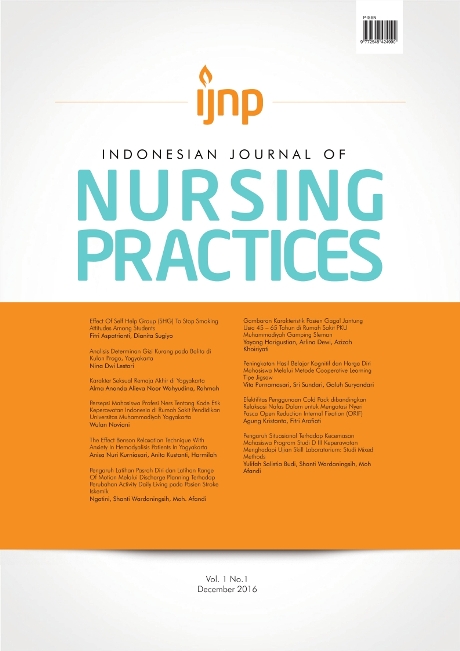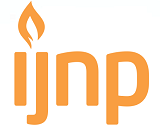PENGARUH ACTIVE CYCLE OF BREATHING TECHNIQUE TERHADAP PENINGKATAN NILAI VEP1, JUMLAH SPUTUM, DAN MOBILISASI SANGKAR THORAKS PASIEN PPOK
DOI:
https://doi.org/10.18196/ijnp.v1i2.3437Keywords:
Active Cycle of Breathing Technique (ACBT), Penyakit Paru Obstruksi Kronik, Bersihan Jalan Napas, Ekspansi Toraks, VEP1.Abstract
ABSTRAK
Salah satu bagian integral dari manajemen COPD adalah membersihkan jalan nafas untuk mengatasi gejala klinis seperti produksi sputum dan sesak napas yang menyebabkan penurunan VEP1, produksi sputum yang berlebihan, dan terganggunya mobilisasi toraks. Perawat dapat membantu pasien PPOK untuk memulihkan kondisi fisiknya dan memperbaiki pola nafasnya dengan memutus mata rantai keluhan yang ada dengan Active Cycle of Breathing Technique (ACBT). Tujuan penelitian ini untuk mengetahui pengaruh ACBT terhadap peningkatan nilai VEP1, pengurangan jumlah volume sputum, dan peningkatan mobilisasi sangkar toraks pada penderita PPOK. Penelitian ini merupakan penelitian Quasi Experiment dengan rancangan pre–post test with control group design. Sebanyak 30 orang pasien dibagi kedalam 2 kelompok yaitu 15 responden untuk kelompok intervensi dan 15 responden untuk kelompok kontrol dengan menggunakan teknik quota sampling. Analisis yang digunakan adalah uji t-test. Kelompok intervensi diberikan terapi ACBT dan farmakologi dan kelompok kontrol hanya diberikan terapi farmakologi. ACBT memberikan pengaruh yang bermakna terhadap jumlah sputum dan ekspansi toraks pada kelompok intervensi daripada kelompok kontrol dengan nilai p = 0,026 untuk jumlah sputum dan p = 0,004 untuk ekspansi toraks, sedangkan pada nilai VEP1, ACBT tidak memberikan pengaruh yang bermakna dengan nilai p = 0,058. Active Cycle of Breathing Technique (ACBT) efektif dalam membantu pengeluaran sputum dan meningkatkan ekspansi toraks pasien PPOK, tetapi kurang efektif dalam meningkatkan nilai VEP1.
ABSTRACT
Airway clearance is an integral part of the management of COPD to cope clinical symptoms such as sputum production and shortness of breath that causes impairment VEP1, excessive sputum production, and impaired toraks mobilization. Nurses can help COPD patients to break the chain of the existing complaint with the Active Cycle of Breathing Technique (ACBT). The purpose of this study was to determine the effect of ACBT in increasing VEP1, reducing amount of sputum, and increasing mobilization of the thoracic cage in COPD patients. This is a Quasi Experimental study with pre-post test with control group design. The 30 participants were divided into experimental group (15 subjects) and control group (15 subjects) by using quota sampling. The experimental group received ACBT and pharmacological therapy and the control group just received pharmacological therapy. Result findings show that ACBT give a significant effect on the amount of sputum and thoracic expansion in the intervention group than the control group, with p = 0.026 and p = 0.004 respectively, while for the value of VEP1, ACBT not provide significant effect with p = 0.058. ACBT effective in helping expenditures sputum and increasing thoracic expansion COPD patients, but less effective in enhancing the VEP1.
References
Dipiro, Cecily V, Wels, Barbara G, Dipiro, Joseph T, Schwinghammer, Terry L. (2015). Pharmacotherapy Handbook, 9th Edition. United States: McGraw-Hill Education.
Kementrian Kesehatan RI. (2015). Rencana Strategis Kementrian Kesehatan Tahun 2015 – 2019. Jakarta: Keputusan Menteri Kesehatan Republik Indonesia Nomor HK.02.02/MENKES/52/2015.
Eaton, T., Young, P., Zeng, I., et al. (2007). A randomized evaluation of the acute efficacy, acceptability and tolerability of Flutter and Active cycle of breathing with and without postural drainage in non-cystic fibrosis bronchiectasis, Chron. Respir. Dis.; 4 (1) :23-30.
Faisal, Mohamed, C.K., Puneeth, B., Devi, Renuka.M., & Ajith S. (2012). Efficacy Of Active Cycle Breathing Technique and Postural Drainage In Patients With Bronchiectesis – A Comparative Study. Innovative Journal of Medical and Health Science 2: 6 Nov – Dec (2012) 129 – 132. Retrievied from http://www.innovativejournal.in/index.php/ijmhs.
Global Initiative for Chronic Obstructive Lung Disease (GOLD). (2015). Global Strategy for the Diagnosis, Management, and Prevention of Chronic Obstructive Pulmonary Disease, Update 2015. GOLD. USA.
Haraguchi Mizuha, Nakamura Hidetoshi, Sasaki Mamoru, Miyazaki Masaki, Chbachi Shotaro, Takahashi Saeko, Asano Koichiro, Jones Paul, Betsuyaku Tomoko, K-CCR group. (2016). Determinants of chronic obstructive pulmonary disease severity in the late-elderly differ from those in younger patients, BMC Res Notes (2016), 9:7
Hidayat Faqih. (2015). Penatalaksanaan Fisioterapi pada PPOK di BBKPM Surakarta. Naskah Publikasi, Fakultas Ilmu Kesehatan, UMS.
Ikalius, Yunus F, Suradi, dan Rachma N. 2007. Perubahan Kualitas Hidup dan Kapasitas Fungsional Penderita Penyakit Paru Obstruktif Kronis setelah Rehabilitasi Paru.Majalah Kedoteran Indonesia.Vol 57. No12: Desember. hal 447
Kementrian Kesehatan RI. (2013). Riset Kesehatan Dasar (Riskesdas). Jakarta: BPPK KEMENKES RI.
Khotimah, S. (2013). Latihan Endurance Meningkatkan Kualitas Hidup Lebih Baik dari pada Latihan Pernafasan Pada Pasien PPOK di BP4 Yogyakarta. Sport and Fitness Journal. Volume 1, No. 1: 20-32.
Lamuvel, MW.,Kazi A.,Gunjal S.,Jaiswal Amit. (2016). Effect of ACBT and TENS on Pulmonary Function and Pain Perception in Abdominal Surgeries: A Randomized Control Trial, International Journal of Health Sciences & Research. 2016; 6 (6) : 211-217.
Lewis, L.K., Williams, M.T., & Olds, T.S., (2012). The Active Cycle Breathing Techniques : A Systematic Review and Meta-Analysis. Respir Med. 2012 Feb;106 (2) :155-72. doi: 10.1016/j.rmed.2011.10
Maranata, Daniel. (2010). Buku Ajar Ilmu Penyakit Paru 2010. Surabaya: Departemen Ilmu Penyakit Paru FK Unair-RSUD Dr.Soetomo.
Melam, G.R., Zakaria, A.R., Buragadda, S., Sharma, D., & Alghamdi, M.A. (2012). Comparison of Autogenic Drainage & Active Cycle Breathing Techniques on FEV1, FVC & PERF in Chronic Obstructive Pulmonary Disease. World Applied Sciences Journal, 20 (6): 818-822, 2012, ISSN 1818-4952, DOI: 10.5829/idosi.wasj.2012.20.06.71125.
Oemiyati, R. (2013). Kajian Epidemiologis Penyakit Paru Obstruktif Kronik (PPOK). Jakarta: KEMENKES RI
Pawadshetty Vishvanath, Munde Sarita, Sureshkumar, Pawadshetty Uma. (2016). A Study To Evaluate The Effect Of ACBT Over Autogenic Drainage Technique In COPD Patients-A Comparative Study (Abstract). Indian Journal of Physiotherapy and Occupational Therapy-An International Journal Abstract, Volume 10, Issue 4, DOI : 10.5958/0973-5674.2016.00125.8.
Perhimpunan Dokter Paru Indonesia. (2011). Penyakit Paru Obstruktif Kronik (PPOK): Pedoman Dignosis dan Penatalaksanaan Di Indonesia. Jakarta
Potter, P.A., Perry, A.G. (2006). Buku Ajar Fundamental Keperawatan, Edisi 4, Volume 2. Jakarta: EGC.
Pryor J., Prasad S. (2008). Physiotherapy for Respiratory and Cardiac Problems Adults and Paediatrics, 4th Edition. London: Churchill Livingstone.
Rab, T. (2010). Ilmu Penyakit Paru. Jakarta: Trans Info Media.
Rabe, KlausF., Hurd, Suzanne., Anzueto, Antonio., Barnes, Peter J., Buist, Sonia A., Calverley, Peter., Fukuchi, Yoshinosike., Jenkins, Christine., Rodriguez-Roisin, Roberto., Weel, Chris van., and Zielinski, Jan. (2007). Global Strategy for the Diagnosis, Management, and Prevention of Chronic Obstructive Pulmonary Disease, GOLD Executive Summary. Leiden University Medical Center, Pulmonology, Leiden, The Netherlands
Respira. (2015). Data 10 Besar Penyakit Pasien Rawat Inap dan Rawat Jalan. Yogyakarta: Rumah Sakit Paru Respira Yogyakarta.
Lestari, Ririt Ika. (2015). Manfaat Active Cycle Of Breathing Technique (ACBT) Bagi Penderita PPOK. Naskah Publikasi, Program Studi Fisioterapi, Universitas Muhammadiyah Surakarta
Senthil P, Suchithra E, Koushik Kumar N. (2015). Effectiveness of active cycle of breathing techniques [Acbt] Versus Acbt with Acapella on airway clearance in bronchiectasis, International Journal of Physical Education, Sports and Health 2015; 1(4): 10-13.
Sherwood, L. (2015). Fisiologi Manusia: Dari Sel ke Sistem, Edisi 8. Jakarta: EGC
Smeltzer, S.C., Bare, B.G. (2002). Buku Ajar Keperawatan Medikal Bedah, Volume 1. Jakarta: EGC.
Subagyo, Ahmad. (2013). Nilai normal faal paru orang Indonesia pada usia sekolah dan pekerja dewasa berdasarkan rekomendasi American Thoracic Society (ATS) 1987 oleh Alsagaff H, Mangunegoro H. Airlangga University Press. Surabaya 1993. diakses dari: http://kolegiumpulmonologi.com/pdf/Nilai_Normal_Faal_Paru_Orang_Indonesia.pdf dan http://www.klikparu.com/2013/09/nilai-normal-faal-paru-indonesia.html
Swartz, Mark H. (1995). Buku Ajar Diagnostik Fisik. Jakarta
Downloads
Published
Issue
Section
License
License
Articles published in the IJNP (Indonesian Journal of Nursing Practices) are licensed under a Attribution 4.0 International (CC BY 4.0) license. You are free to:
- Share — copy and redistribute the material in any medium or format.
- Adapt — remix, transform, and build upon the material for any purpose, even commercially.
This license is acceptable for Free Cultural Works. The licensor cannot revoke these freedoms as long as you follow the license terms. Under the following terms:
Attribution — You must give appropriate credit, provide a link to the license, and indicate if changes were made. You may do so in any reasonable manner, but not in any way that suggests the licensor endorses you or your use.
- No additional restrictions — You may not apply legal terms or technological measures that legally restrict others from doing anything the license permits.
Copyright
Authors who publish with IJNP (Indonesian Journal of Nursing Practices) agree to the following terms:
- Authors retain copyright and grant IJNP (Indonesian Journal of Nursing Practices) the right of first publication with the work simultaneously licensed under an Attribution 4.0 International (CC BY 4.0) that allows others to remix, adapt and build upon the work with an acknowledgment of the work's authorship and of the initial publication in IJNP (Indonesian Journal of Nursing Practices).
- Authors are permitted to copy and redistribute the journal's published version of the work (e.g., post it to an institutional repository or publish it in a book), with an acknowledgment of its initial publication in IJNP (Indonesian Journal of Nursing Practices).















